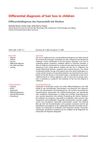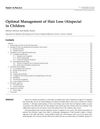TLDR Migrant and minority communities face higher rates of alopecia due to genetic, environmental, and cultural factors, needing better healthcare access and culturally aware treatments.
The review examines the prevalence and impact of different types of alopecia in migrant and ethnic minority communities, highlighting significant disparities influenced by genetic, environmental, and sociocultural factors. Alopecia areata (AA) and telogen effluvium (TE) are more prevalent in minority groups, with TE incidence increasing by over 400% during the COVID-19 pandemic in these communities. Androgenetic alopecia (AGA) is rising among Asians due to acculturation, while traction alopecia (TA) is common among women of African descent due to cultural hair practices. The study underscores the need for equitable healthcare access and culturally competent interventions to address these disparities, reduce stigma, and improve quality of life, suggesting that specialized clinics and digital platforms could enhance access and contribute to real-world evidence.
 30 citations
,
May 2004 in “Journal der Deutschen Dermatologischen Gesellschaft”
30 citations
,
May 2004 in “Journal der Deutschen Dermatologischen Gesellschaft” The document concludes that early diagnosis and treatment are crucial for children with hair loss to prevent permanent damage, although not all conditions can be effectively treated.
 49 citations
,
January 2003 in “American Journal of Clinical Dermatology”
49 citations
,
January 2003 in “American Journal of Clinical Dermatology” Effective management of children's hair loss involves accurate diagnosis, various treatments, and supportive care.
 October 2025 in “Dermatology Practical & Conceptual”
October 2025 in “Dermatology Practical & Conceptual” ChatGPT 4.0 and Gemini 1.5 Flash are effective for educating patients about androgenetic alopecia, while Deepseek R1 is less reliable.
 47 citations
,
December 2020 in “Journal of the European Academy of Dermatology and Venereology”
47 citations
,
December 2020 in “Journal of the European Academy of Dermatology and Venereology” The document concludes that understanding and treating hair loss requires recognizing its various types and using appropriate diagnostic tools and treatments.
 June 2025 in “Naunyn-Schmiedeberg s Archives of Pharmacology”
June 2025 in “Naunyn-Schmiedeberg s Archives of Pharmacology” Herbal remedies may help with hair loss but need more research.
 1 citations
,
July 2017 in “Clinical research in dermatology”
1 citations
,
July 2017 in “Clinical research in dermatology” Hair loss, known as Androgenetic Alopecia, is often caused by hormones and can be diagnosed using noninvasive techniques. Treatments include topical minoxidil and oral finasteride, with new treatments being explored. There may also be a link between this type of hair loss and heart disease risk.






